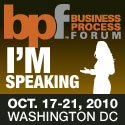The title of Jim Sinur’s breakfast session this morning is based on the “lack of respect” that rules have as a key component in business processes: as he pointed out, it’s very difficult to explain to a business executive what business rules do and their value (something to which I can personally attest). I’ve been talking about the value of externalizing rules from processes for a number of years, and Jim and I are definitely on the same page here. He has some numbers to back this up: a rules management system can expect to show an IRR of 15%, and in some industries that are very rules-intensive, it can be much higher.
Rules are everywhere: embodied in multiple systems, as well as in manual procedures and within employee’s heads; it goes without saying that there can be inconsistent versions of what should be the same rule in different places, leading to inconsistent business processes and outcomes. Extracting the rules out of the systems – and with more difficulty, from people’s heads – and managing them in a common rules system allows those rules to become more transparent (everyone can see what the rules are) and agile (a rule change can be made in one place but may impact multiple business processes and scenarios). Or as he said, rules are much easier to manage when they are managed. 🙂
Not all rules, however, are business rules and therefore are a fit for externalization: the best fit are those that truly have a business focus and have some degree of volatility, such as regulatory compliance rules or the rules that you use for underwriting; those with a poor fit for BRMS are system rules that might be better left in code. Once the business rules have been identified, the next challenge is to figure out which of these should actually be managed directly by the business. IT will tell you that allowing the business to change any rule without a full regression testing is dangerous; they’re wrong, of course, since your initial testing of rules should test the envelope within which the business can make rule changes. However, Jim’s suggestion is to have business and IT each state which rules that they want to manage, and just deal with those that claimed by both, by examining the impact of the changing rules within that area of overlap. Basically, if a change to a rule can’t result in any system meltdown or violation of business practices, there’s usually not a good reason not to allow the business to manage it directly.
As with the Gartner definition of BPM, BRM is defined as both a management discipline as well as the tools and technology: just as we have to get organizations to think in a process-centric manner in order to implement effective BPM systems, organizations have to think about rules management as a first-class member of their analysis and management tools. Compared to BPM, however, BRM is further back in the hype cycle: just approaching the peak of inflated expectations, whereas BPA is far out in the plateau of productivity and BPMS is dipping into the trough of disillusionment. Jim predicts that BRM will become important (especially in the context of BPM) in 5-10 years, unless some catastrophic event or legislation causes this to accelerate; this is expected to show high benefit, although not necessarily transformational as BPM is expected to be.
There’s been a lot of acquisition in the rules space, and the number of significant players has dropped from 40+ to about 15 in the past few years. There’s still quite a bit of variability in BRM offerings, however, ranging from the simple routing and branching available within BPMS, to inference engines where rules are fired based on terms and facts either through forward-chaining or backward-chaining, to event-based engines that fire based on the correlation of business and system events. Really, however, the first case is a BPMS, the second is a typical BRMS, and the third is complex event processing, but these boundaries are starting to shift. Rules technology is being seen in BPMS and CEP, but also within application development environments and packaged applications.
He did an overview of BRMS technology, starting with business rule representation: there’s a whole spectrum of rule representation, ranging from proto-natural languages through to the (as yet non-existent) natural language rules. In order to be considered a BRMS (as opposed to just a BRE), a product needs to include a rules repository, modeling and simulation, monitoring and analysis, management and administration, templates, and an integrated development environment, all centered around the rule execution engine.
Combining rules and process is really the sweet spot for both sides: allowing business rules to be externalized from processes so that they can be reused across processes (and other applications), and changed as required by the business, even for in-flight processes. Rules can be used as constraints for unstructured processes, where you don’t need to know ahead of time exactly what the process will look like, but the goals must be achieved – and validated by the rules – before the process instance is completed. The simple routing rules that exist within some BPMS just isn’t sufficient for this, and most BPM vendors are starting to realize that they either need to build their own BRMS or learn to integrate well with some of the full-featured BRMS.
He wrapped up with some key takeaways and recommendations: focus on real business rules; learn how BRM can become part of your management practices as well as technology portfolio; marry BPM and BRM, potentially within the same CoE; and see rules and processes as metadata-driven assets.

